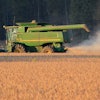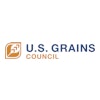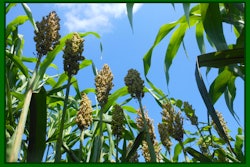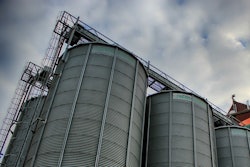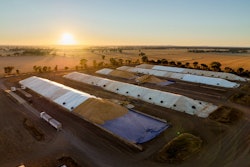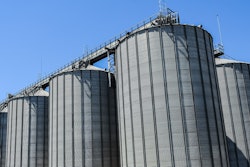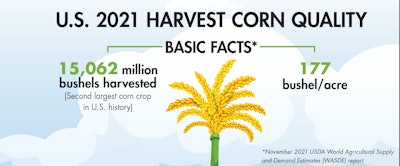
The 18 states that plant 92% of the corn in the U.S. have already started or are preparing for the 2022/2023 harvest.
TheUnited States Department of Agriculture(USDA)National Agricultural Statistics Service(NASS)'scrop progress reportreleased on September 26, 2022, shows a slight decline in corn quality when compared to last year's harvest due to weather conditions.
Despite the decline, U.S. corn farmers will still produce alarge, high-quality crop.
High quality is a big advantage for marketing corn
The quality of the U.S. corn crop, and its ability to both store and transport it without losing quality, is a big advantage when marketing it to importers.
Every yearU.S. Grains Council(USGC) produces theCorn Harvest Quality Reportto show importers why the U.S. crop is so high quality.
This infographic, which first appeared in theJune/July 2022issue ofFeed & Grain, highlights some of the most impressive stats from the 2021 Corn Harvest Quality Report. But what makes a good grain crop?
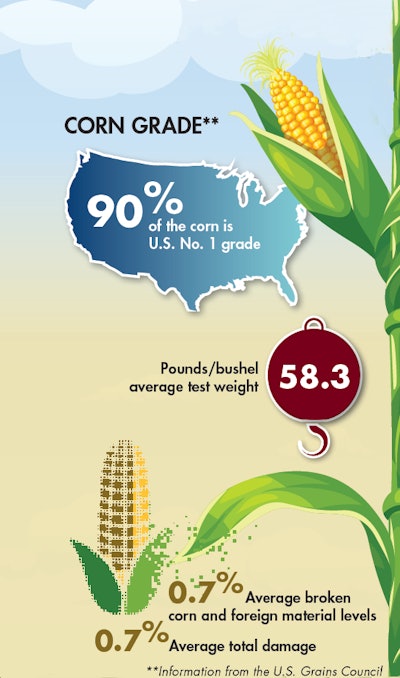
How the USDA grades corn
Roughly 90% of the 2021/2022 U.S. corn crop was rated U.S. No. 1, the USDA's highest grade for corn. Corn harvested in the U.S will go into one of six classes, with U.S. No. 1 being the highest grade and U.S. Sample grade being the lowest. The grain is assigned based on a minimum test weight/bushel and maximum limits of damaged kernels, broken corn and foreign material.
To receive the U.S. No. 1 grade, the crop must achieve a Minimum test weight of 56 pounds/bushel, have less than 0.1% of heat-damaged kernels, less than 3% of damaged kernels overall, and less them 2% of broken corn and foreign material.
Corn that receives the U.S. Sample grade either doesn't meet the requirements for U.S. No. 5 (46-pounds test weight/bushel, 3% heat-damaged kernels, 15% damaged kernels, 7% broken corn and foreign material). It is also labeled U.S. Sample grade if contains stones with an aggregate weight in excess of 0.1% of the sample weight, two or more pieces of glass, three or more crotalaria seeds, two or more castor beans, four or more particles of an unknown foreign substance or a commonly recognized harmful or toxic substance, eight or more cockleburs or similar seeds singly or in combination, or animal filth in excess of 0.20% in 1,000 grams. A musty, sour, or commercially objectionable foreign odor will also give corn that U.S. Sample grade.
How corn test weight is determined
The University of Wisconsin Extension-Fond du Lac Co., releasedUnderstanding Corn Test Weightexplaining how the U.S. bushel measuring system works. The U.S. still measures corn by bushel for both weight and volume. This makes test weights necessary when paying producers because an official bushel is 1.244 cubic feet. Of course, the amount of corn that fits into 1.244 cubic feet can vary greatly depending on the size, density, shape, slickness of the outer kernel layer, and moisture content. So the U.S. buys and sells corn by weight in 56-pound segments, also called bushels, based on the weight of 1.244 cubic feet of U.S. No. 1 corn at 15 to 15.5% grain moisture content.
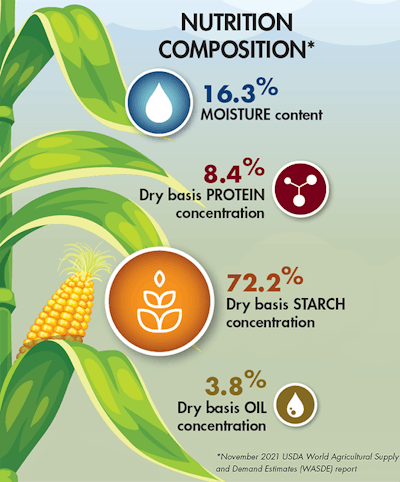
Why heat-damaged kernels are measured separately
It may seem odd that heat-damaged corn kernels have different thresholds than other types of kernel damage. But according toCorn Grades and Feed Valueby the University of Kentucky, "Heating can reduce energy and protein availability to consuming animals. The total amount of damaged kernels and the type of damage could reduce animal intake and reduce feeding value proportional to the number of carbohydrates used up in the damage process."
The USDA considers corn the primary U.S. feed grain, and reports that it accounts for over 95 percent of total feed grain production and use. It accounts for 40% of domestic corn use, making anything that affects its nutritional value vital in the grading scale.
Besides heat, kernels can be damaged by frost, weathering, disease, mold, sprouting or grinding.
破碎的玉米粒邀请进一步损害
Besides damaged kernels, the USDA grading system also separates broken corn and foreign material into separate categories.
Broken kernels are usually created when the grain is handled in some way. Usually, during harvest, transportation or being put into and out of storage. The USDA definition of broken corn as any that falls through a 12⁄64 round-hole sieve and over a 6⁄64 round-hole sieve. Broken kernels may be nutritionally fine but are much more susceptible to grain storage hazards like insect damage and mold growth.
Foreign material is any substance that is not corn, as long as it is not glass, crotalaria seeds, castor beans, commonly recognized harmful or toxic substances cockleburs or similar seeds, or animal filth in excess of 0.20% in 1,000 grams. All of those can immediately get a load of corn a U.S. Sample grade depending on the quantity found. Commonly found foreign material includes other grain, weed seeds, bits of plant matter and stones.
The U.S. produces a quality corn crop
它需要很多实现美国1号玉米研究生e, making it all the more impressive that 90% of the corn harvested in 2021 not only achieved this rating but, on average, beat the minimum requirements. The quality of U.S production and grain handling operation is a selling point for the world's corn importers.
The original version of the infographic, as seen in print, can be foundhere.

.jpg?auto=format%2Ccompress&crop=faces&fit=crop&h=48&q=70&w=48)
